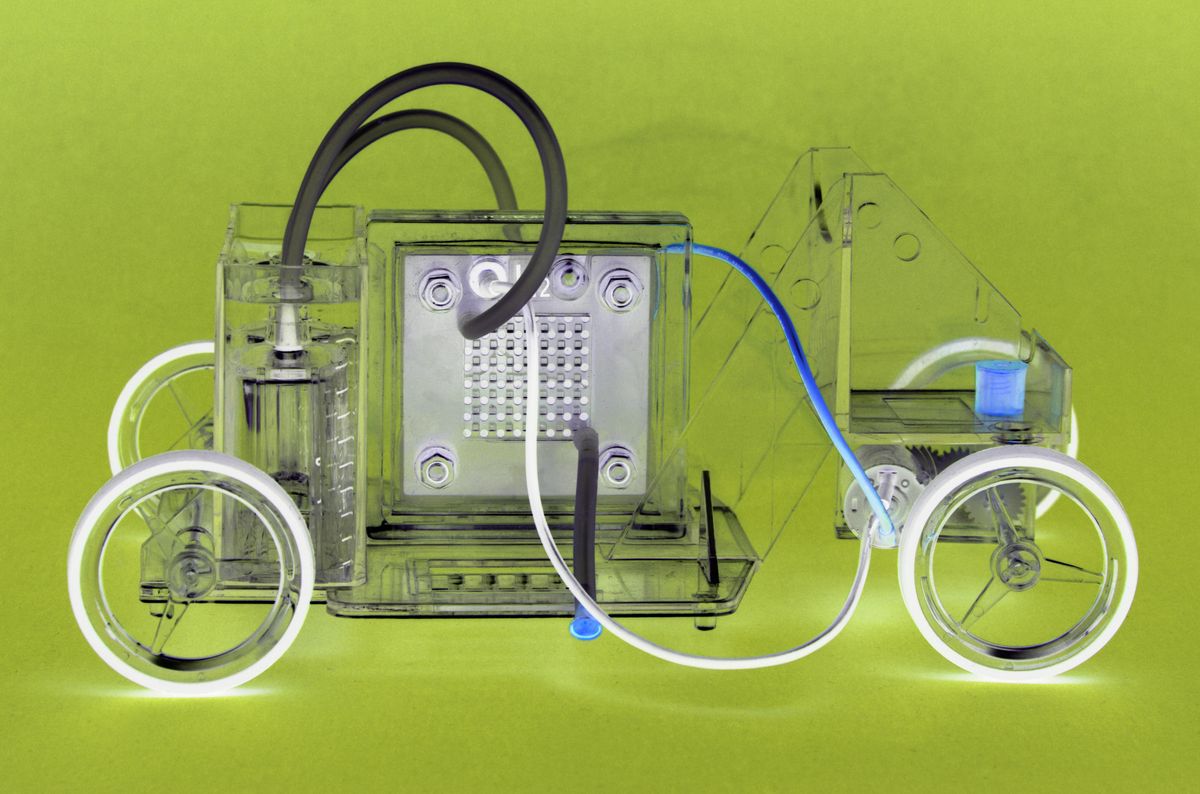Conventional hydrogen fuel cells hold great promise as clean, efficient sources of energy for vehicles and other applications, but they rely on precious-metal catalysts that drive up their cost. Now scientists have created a precious-metal-free hydrogen fuel cell with a record-high performance and durability and virtually negligible catalyst costs.
Hydrogen, the most common element in the universe, has long been touted as a clean and abundant energy alternative to fossil fuels—or at least as an ample storage medium for renewable-generated power to portably run big machinery like trains, planes, and trucks. When hydrogen reacts with oxygen in fuel cells to generate electricity, instead of yielding pollutants as fossil fuels do, the result is simply water.
Standard hydrogen fuel cells rely on acidic chemicals and catalysts made of precious metals such as platinum to drive the reactions between hydrogen and oxygen that generate electricity. In contrast, alkaline polymer electrolyte fuel cells rely on alkaline chemicals and can use earth-abundant metals as catalysts, eliminating the need for precious metals. However, these latter fuel cells still fall short on performance and durability compared to conventional fuel cells.
Now scientists have developed a precious-metal-free alkaline polymer electrolyte fuel cell with a record-high peak power density of 210 milliwatts per square centimeter, more than five times as much power as its previous counterparts.

The new device relies on a catalyst made of a solid nickel core surrounded by a shell 2 nanometers thick made of carbon doped with nitrogen. This catalyst is located at the anode, where the hydrogen is oxidized, or loses electrons, and is paired with a cobalt-manganese catalyst at the cathode, where oxygen is reduced, or gains electrons.
The carbon layers on the new anode catalyst help boost the rate at which hydrogen is oxidized, and the nitrogen in these carbon layers can serve as sites to spur oxidation, altogether boosting fuel cell performance. In addition, the anode catalyst’s shell prevents the nickel from oxidizing to form nickel oxides that can both dramatically slow hydrogen oxidation and lead the catalyst to deteriorate.
The new catalyst also proved dramatically more tolerant to carbon monoxide than platinum. Commercial production of hydrogen gas often results in trace amounts of carbon monoxide, so a high tolerance to carbon monoxide is key to practical hydrogen fuel cell applications.
The scientists found their new fuel cell could operate in a stable manner for more than 100 hours. In comparison, another precious-metal-free fuel cell using nickel nanoparticles essentially stopped operating within 5 hours.
The scientists do note that a conventional fuel cell with precious-metal catalysts operating under acidic conditions can deliver about 1.2 to 1.5 watts per square centimeter, roughly five to seven times as much as the new fuel cell. Still, “one has to keep in mind that acidic fuel cells have been under development for decades, while alkaline ones have been for less than 10 years,” says study coauthor Héctor Abruña, an electrochemist at Cornell University in Ithaca, New York. “We feel confident that with further developments and some optimization, we could reach 1 watt per square centimeter within two to three years, which would be a major and enabling breakthrough.”
Future research might boost the fuel cell’s durability by improving the support membranes within the device, Abruña says. “While these results are very promising, a significant amount of work remains before these devices can be broadly deployed,” he notes.
The scientists detailed their findings online 21 March in the journal Proceedings of the National Academy of Sciences.
- Carbon Nanotubes Go Back Inside Fuel Cells - IEEE Spectrum ›
- Nanoscale Material Enables Cheap, Emission-free Hydrogen ... ›
Charles Q. Choi is a science reporter who contributes regularly to IEEE Spectrum. He has written for Scientific American, The New York Times, Wired, and Science, among others.



